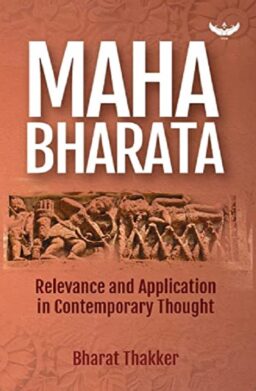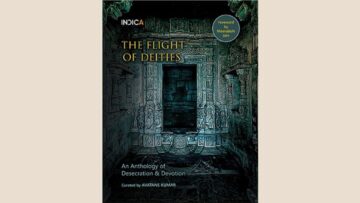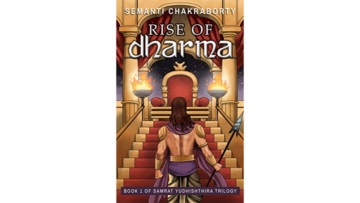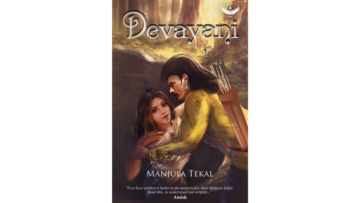A magnificent building without a foundation is ‘Mahabharata: Relevance and Application in Contemporary Thought’. Indeed it is very interestingly conceived. The book is written by a businessperson Bharat Thakker. Its objective is to present the Mahabharata, keeping in mind today’s world and prevailing issues. The intent of this book is to present guidance on dharma and other concepts by relating it to contemporary issues.
The concept of this book is exciting, and thanks to Indica Books, I got a copy of it. I started reading eagerly and was happy with the way the book was presented. The book is structured very well. The author starts with basic concepts like dharma, karma, Hindu way of life, etc. He then introduces the great epic’s characters and subsequently starts with the book’s core.
Part B of the book has all the events of the Mahabharata neatly arranged in chapters starting from the story of Kuru dynasty. Each chapter presents the story pertaining to that segment, followed by the author’s commentary and a detailed analysis, which is the highlight of this book. The author talks about many concepts from the Mahabharata that are relevant to today’s times.
He used the Kuru dynasty to talk about issues like succession. The story of Satyavati is related to pre-nuptial agreements. He talks about rights of women, concept of Niyoga and surrogacy, intellectual property (referring to the knowledge of divyastras), inter-racial relationships, etc.
The author has to be commended for doing a painstaking analysis and trying to relate the Mahabharata to contemporary situations. An in-depth analysis has been done on almost every chapter from the Mahabharata until the end of the story. The author has tried to bring out the concept of dharma and explained its significance and application elaborately.
This book, in theory, has all the elements that are needed to make it truly an epic. It should have been a book to be kept in every library and even used as a text book. But my review of this book is that I do not recommend it to others. If you are surprised by this recommendation, you must know it is so because the book fails at a very basic requisite.
The author has constructed a magnificent palace, but alas it has been constructed on a foundation of sand. The very foundation of this book is the Mahabharata of Vyasa. In his introduction, the author has rightly highlighted the importance of the critical edition of the Mahabharata brought out by BORI (Bhandarkar Oriental Research Institute).
But tragically, the author ignored the critical edition while writing this book. In fact, the author seems to have ignored all well-known editions of the book. He has based his book on myths, misconceptions, and TV shows. The story of the Mahabharata that the book presents is not the original story by Vyasa.
The author has blended a concoction of folk tales and myths trying to project it as the Mahabharata. The end result is that the book turns out to be an analysis giving a completely wrong picture of the greatest epic in the world. The book makes it appear as though Duryodhana was a hero fighting for his rights and the Pandavas were in the wrong.
The author’s version of the Mahabharata makes it appear that Krishna was a master manipulator. The book seems to suggest that it was Krishna who ensured Draupadi married Arjuna. It also projects him as someone who misused his influence over the Pandavas to get rid of Jarasandha for his personal benefit.
The author’s story perpetuates many sad myths. It talks about Draupadi mocking Dhritarashtra’s physical disability, a clear reference to the BR Chopra show although in reality, Draupadi never mocked anyone. The book also has the usual tropes of Karna being discriminated because of his caste. There is reference to Aryans and non-Aryans, discrimination, and the list goes on. There is also a ridiculous reference to Ravana being an advocate of consent and not touching Sita because she did not give her consent.
Sample some of the content this book has:
- Kunti curried favour with the Brahmanas by taking good care of them, so they would support her sons’ claim to the throne.
- Karna had a son surviving who should have been the successor. Here again, the author resorts to pulp fiction because in the original Mahabharata, no son of Karna survives the war.
- Bheeshma forced Gandhari to marry Dhritarashtra.
- The Pandavas got Khandavaprastha on the condition that Kunti should not go with them but remain in Hastinapura.
- Ashwatthama took the heads of the persons he killed on the night the war ended. Seeing them Duryodhana realised it was the sons of the Pandavas. He died heartbroken that the future Kuru princes were dead.
- Bheema drank Dusshasana’s blood and then used it to wash Draupadi’s hair – a very common myth.
- Bheeshma had five arrows to kill the Pandavas, but Arjuna took it away from Duryodhana and thus saved the Pandava lives.
- Yudhistira saved Duryodhana from the Gandharvas because he did not want the Gandharvas to rule Hastinapura.
- Arjuna did not kill any of Duryodhana’s son, so he was not a great warrior.
There are much more such myths the book talks about. If the author had spent some reading the original Mahabharata, all this could have been avoided. There is also a possibility that the author has inserted all these fake stories to suit his narrative. The author makes a shocking comparison equating the dharma yuddh of Mahabharata to Jihad.
All these gross misinterpretations of Vyasa’s epic create a bad effect. In fact, I am of the view the entire utility of this book is lost because the author has failed to present the real story of the Mahabharata. Of what use is all those wonderful analyses when they are not based on the real Mahabharata?
If the book were fiction, the author could have gotten away by claiming creative liberty. But this is a book of knowledge. It is a book where the author says he is presenting the story of the Mahabharata for today’s contemporary times. A great disservice has been done by presenting a wrong version of the Mahabharata.
People, especially youngsters who read this book, will get the impression that the myths stated in this book represent the real Mahabharata. They may end up feeling that the Kauravas were not really bad, and actually the Pandavas and Krishna were the bad guys. The very essence of the Mahabharata would be lost if this happened.
It is tragic that the author has failed to present the true story of the Mahabharata. All the hard work put into this book is of no use because the very foundation of the book is flawed. Only for this reason, I do not recommend this book to anyone.
I appeal to the author to read the BORI Critical Edition (or any of the editions) thoroughly to understand the real story of the Mahabharata. If the author can then revise the book and bring out a second edition, the book would truly be a masterpiece. It would be a wonderful analysis and exposition of Vyasa’s Mahabharata, one that should be there in every library.
I rate this book 2/5. The rating is for the structure, presentation, and analyses done. But since the very basis of the book is incorrect, I deduct 3 stars from my rating.
Disclaimer: The opinions expressed in this article belong to the author. Indic Today is neither responsible nor liable for the accuracy, completeness, suitability, or validity of any information in the article.











